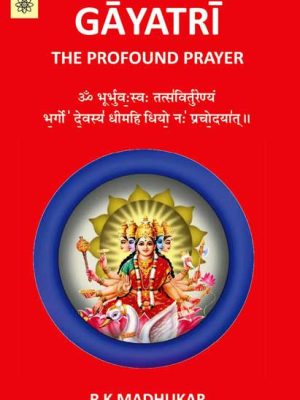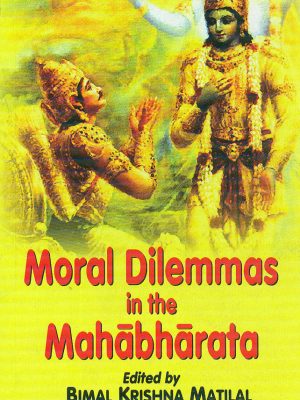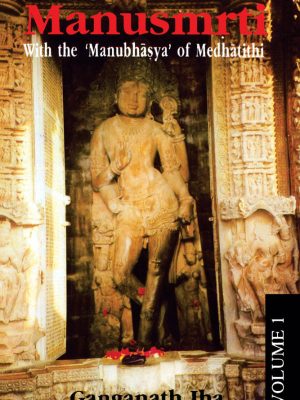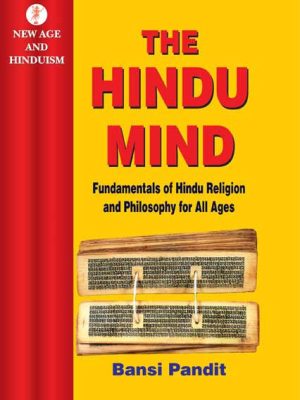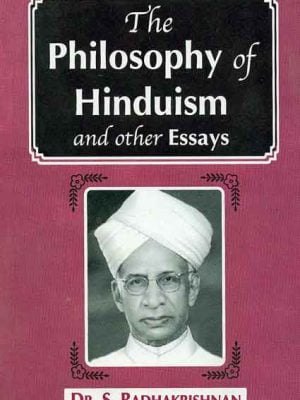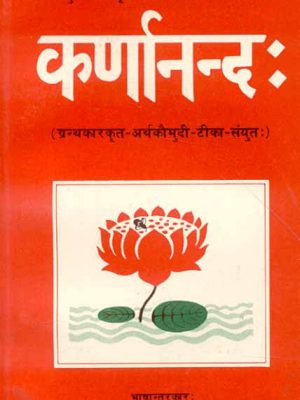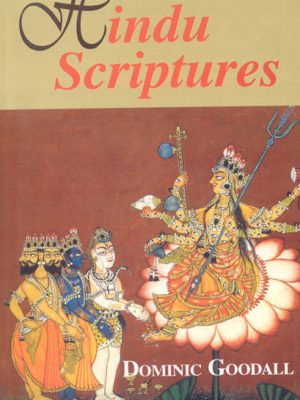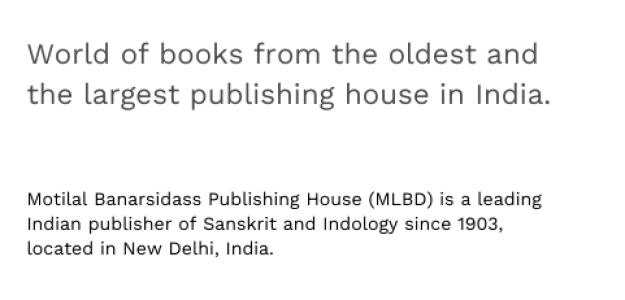
Motilal Banarsidass Publishing House
-
Gayatri: The profound prayer
Gayatri: The profound prayer
Gayatri is a profound prayer. It is an authentic prayer that elevates, exhilarates and enlightens. According to Hindu scriptures, a prayer in its real sense is not just chanting of a few verses. It is a comprehensive exercise that involves jnana (knowledge), dhyana (meditation) and anubhava (experience). Gayatri Mahamantra is a true prayer that not only reaches out but also reaches in.
Gayatri is chanted as a Mahamantra, worshipped as the Mother Goddess and expressed as a Meter. It is not a prayer for worldly and material benefits. Gayatri is a prayer for the highest enlightenment. It is a prayer that leads to a sublime experience, a prayer that opens up our mind and vision, body and intellect to a world beyond the worldly attachments. It is a prayer that leads to the Ultimate Truth and Supreme Bliss that every enlightened human being seeks.
Gayatri, like the Vedas, is meant for the entire mankind, irrespective of gender, caste, creed, religion or nationality. It is a profound prayer that can touch and transform every human being.
This book is a good read for everyone who believes in the efficacy of prayer and meditation. It is also a good read for everyone who wishes to gain an insight into the breadth and depth of ancient Indian wisdom – the Sanathana Dharma. This informative book is meant for every generation, both young and old.
Review(s)
Gayatri-The Profound Prayer is the authorÍs first spiritual book. Writing it has been a divine spiritual experience for him. -SWAMI BALAKRISHNANANDA SARASWATHI Founder of Gayatri Tapobhoomi, Tadas, Hubli, Karnataka
Author
Madhukar
₹495.00Gayatri: The profound prayer
₹495.00 -
Moral Dilemmas in the Mahabharata
Moral Dilemmas in the Mahabharata
Here the collected papers explore the whole question of the relation between the mythopoetic and the moral in the context of the Mahabharata. Here we have a story of extreme complexity, characters that are unforgettable, and a cosmic context in which gods and men alike grapple with destiny. The obligations of kinship and friendship jostle with each other. The women characters, as in everyday life, seem to bear a very heavy load of the burden of life and to stand in a key position in almost every conflict. We are presented with predicaments at every turn. At times these predicaments seem to be aggravated by social structure. At other times they are cushioned by it. Philosophical tangles tied up with karma and dharma are interwoven with the mythopoetic material. Perhaps philosophical issues are pinpointed rather more than they are in Greek epic literature.
The essays in this book treat the Mahabharata from an unusual angle, fastening on the moral dilemmas it presents. How universal are the dilemmas faced by the characters in the story, and are the dilemmas in fact resolved? In dealing with these questions, the discussions range over the meaning of the purusarthas, the institutions of marriage and the family, the concept of action in the Gita and the special predicaments faced by Draupadi, Arjuna and others. These studies invite the scholar to reflect afresh on the text and encourage the general reader to find in epic literature much that is relevant to life today.
₹395.00 -
-
A Catalogue of Vaisnava literature: On Microfilms in the Adyar Library, The Bodleian Library and The American University
A Catalogue of Vaisnava literature: On Microfilms in the Adyar Library, The Bodleian Library and The American University
The tragic loss of precious, ancient or old copies of writings from India’s religious heritage continues into the twenty-first century. A small team of photographers and researches spent a total of eighteen months in India, locating, identifying and photographing numerous hand-printed, papers and palm-leaf manuscripts as well as some printed editions from the Vaisnava traditions.
₹495.00 -
Manusmrti, 10 Vols.: With the ‘Manubhasya’ of Medhatithi
Manusmrti, 10 Vols.: With the ‘Manubhasya’ of Medhatithi
Ganganatha Jha’s Mualti-volume Manusmrti, originally published by the University of Calcutta between 1920 and 1939 is as indicated by its subtitle “The Laws of Manu with the Bhasya of Medhatithi”, mainly an edition and translation of the Mula text together with the explanation of the most celebrated commentator. Medhatithi’s Manubhasya has been characterized by one of the leading scholars on Dharmasastra, J. Duncan M. Derrett, as a large repertory of opinion on the meaning of the “Smrti and on some fundamental questions of Dharma and Law.”
The present work is divided into three sets, i.e. Sanskrit Text (Mula), English Translation and Notes. These comprise of two, five and three volumes-in all the ten volumes. The first two volumes are devoted to (Mula) Sanskrit Text. The first consists of first six Adhyayas and the subsequent carries next six Adhyayas from Vii to XII and a detailed Index for both volumes. The next five volumes (Vol.3 to 7) belong to English Translation. The Vol.3 carries Adhyayas I and II, Vol.4 contains Adhyayas III and IV, Vol.5 has Adhyayas V to VII, Vol 6 has Adhyaya 8, and Vol.7 has last four Adhyayas (IX to XII). All volumes contain a detailed Index. The last three volumes (8 to 10 are devoted to detailed Notes conducive to understanding the subject of the Smrti even to an interested average reader. These belong to textual, explanation and comparative respectively. These contain much useful informations
₹25,000.00 -
Hindu Prayers and Meditations
Hindu Prayers and Meditations
Hindus must pray daily morning at sunrise and evening at sunset one must have divine communication with God, and ask Him for Light and Guidance in life. Hindu scriptures abound in prayers. They are of different types and of complex nature, and form part of various rituals and ceremonies. In our daily life, however, we need not be bothered with these complexities. A few simple prayers, will serve our needs beautifully. The only thing we have to constantly keep in mind is the purity of our hearts and sincerity of purpose. We cannot offer prayers precariously and half-heartedly.
Author
D.N. Vidyarthi
₹225.00Hindu Prayers and Meditations
₹225.00 -
Initiation to the Vedas: An abridged edition of The Vedic Experience-Mantramanjari
Initiation to the Vedas: An abridged edition of The Vedic Experience-Mantramanjari
The hymns we find here are prayers. To be able to invocate, that is, to call upon something greater than ourselves and so break our own bounderies is the beginning of wisdom, the source of hope and the condition of joy.
About the Author(s)
RAIMON PANIKKAR was ordained as a Catholic priest and is Professor Emeritus of Religious Studies at the University of California, Santa Barbara. At present he lives in the mountains of Catalunya trying to learn the wisdom of life.
₹295.00 -
Movements with the Cosmic Dancer: On Pilgrimage to Kailash Manasarovar
Movements with the Cosmic Dancer: On Pilgrimage to Kailash Manasarovar
Lakshmi Bandlamudi’s description of her journey to Kailash and Manasarover, representing as they do Purusha and Prakriti, the masculine and the feminine nature of existence, is deeply moving because she connects it to her own inner spiritual quest. Replete with mythical stories regarding Shiva and Parvati, and written with a special emphasis on the feminine, this book is a moving testament of a living faith which has persisted for thousands of years.
Lakshmi Bandlamudi’s script is a sublimely cosmic dance in itself hinting at a difficult life and a less than easy journey; she nonetheless describes her journey to Kailash the home of Shiva, as a transcendental pilgrimage of the soul. The story Tibetan territory she must traverse becomes almost irrelevant in her soul’s searching for answers to questions, which are both personal and universal.
Author
Lakshmi Bandlamudi
₹295.00 -
The Hindu Mind: Fundamentals of Hindu Religion and Philosophy for All Ages
The Hindu Mind: Fundamentals of Hindu Religion and Philosophy for All Ages
Hinduism is the oldest surviving religion on the world. The religions and philosophical literature of Hinduism is vast, diverse and covers thousands of years of accumulated spiritual experiences of Hindu Saints and Seers. This book presents the fundamentals of Hindu religions and philosophical thought in a logical and straightforward manner. The purpose being, to create a story book for further study of Hinduism.
₹500.00 -
The Philosophy of Hinduism and Other Essays
The Philosophy of Hinduism and Other Essays
In the Philosophy of Hinduism – Dr. S. Radhakrishnan, has explained the central features of faiths of Hinduism, its philosophical and spiritual doctrine, religious experience, ethical character and traditional faiths. Hinduism is a process and not a result, a growing tradition and not a fixed revelation as in other faiths. He has compared the Christanity, Islam and Buddhism in the light of Hinduism and stressed that ultimate aim of these religions is the attaintment of universal self. The analysis of religions is highly intellectual and balanced looking to whole hearted response he received for these lectures in U.K. He has been then aclaimed as another Vivekananda. The articles in the book reflect the mind of this great philosopher.
₹250.00 -
Upanisads: (Selections from 108 Upanisads)
Upanisads: (Selections from 108 Upanisads)
Dr. TMP Mahadevan gives here an easy to read translation of selections from the 108 Upanisads. The eternal truths revealed so long ago are still valid today, and in this easy flowing style they provide moments of truth and enlightenment in the modern materialistic world in which we now live.
The first chapter introduces the reader to the back ground of the Upanisads and elucidates the underlying philosophy. A short introduction to each of the following chapters further explains their meaning. Many sayings, known and frequently used, will be found here in their original context.
Author
T.M.P. Mahadevan
₹345.00 -
Karnananda-Krishnachandra Goswami Pranit: (Granthkarkrit-Arthkaumudi-Tika-Sanyukth)
Karnananda-Krishnachandra Goswami Pranit: (Granthkarkrit-Arthkaumudi-Tika-Sanyukth)
Karnananda-Krishnachandra Goswami Pranit’s book summary is as follows: (Granthkarkrit-Arthkaumudi-Tika-Sanyukth) We may learn much from their spiritual culture, which was not only a major factor in shaping the Western world’s history, but which still has a lot to offer us in the present day. The Rig-complex Veda’s symbols, metaphors, and tales codify India’s archaic spirituality, which is proved to be considerably older than has been traditionally supposed by academics. A fascinating mathematical and astronomical code hidden in the Vedic hymns is also revealed in this book. This well-researched and cross-cultural work will fascinate and enhance anyone interested in ancient cultural history, India, archaeoastronomy, or spirituality. It is fascinating.
Author
Hitanand Goswami
₹150.00 -
Hindu Scriptures
Hindu Scriptures
Hindu Scriptures is a unique collection of Hindu texts spanning more than
twenty centuries.
Two anthologies entitled Hindu Scriptures have previously appeared in
the Everyman series alone, that of Nicol MacNicol in 1938 and that of
Professor R.C. Zaehner in 1966. This present title is the enlarged edition
of R.C. Zaehner’s anthology, with the addition of three fresh translations,
its broad range includes arcane hymns of the ancient Aryans, a manual of
prescriptions governing every aspect of the daily life of the orthodox, and
rich poetry that describes with heady sensuality the dalliance of Krsna and
the cowherd women of Vraja in the nights of the autumn moon. The texts are
arranged in chronological order and the Introduction explains the reasons
for their inclusion, sets them in context, and briefly characterizes their
contents.
₹725.00Hindu Scriptures
₹725.00 -
Ramayana (BUCK)
Ramayana (BUCK)
Compared to the western epics, the Ramayana and Mahabharata are more complete story of Hindu, religious, cultural and social imagination and more exact narration of evolutionary rise of man. In this book, William Buck has succeeded better than anyone else in conveying the spirit of the
original.
The task of presenting a faithful image of the original text, its metaphysical nuances as well as its chronological sequence the world’s largest epic in a small book is a stupendous task.
Mainly as a narration, the version of William Buck will serve as an interesting and complete tale to the English speaking reader. Valmiki was called the Adikavi or “first poet” of Sanskrit literature and some of his remarkable talent shines forth in the English rendering. The reader will find pleasure in reading it aloud to himself or the others.
₹795.00Ramayana (BUCK)
₹795.00 -
Mahabharata (Buck)
Mahabharata (Buck)
The Mahabharata is an Indian epic, in its original Sanskrit probably the largest ever composed. It is the story of a dynastic struggle that provides a social, moral, and cosmological background to the climatic battle. The present English rendition is a retelling based on a translation of the Sanskrit original published by Pratap Chandra Roy, Published in the beginning of this century. William buck has condensed the story. The old translation from which he worked covers 5800 pages of print, while his own book is less than a tenth of that length. But by and large, Buck’s rendition reflects the sequence of events in the Sanskrit epic, and he uses the traditional techniques for instance, of stories within stories, flashbacks, moral lessons laid in the mouths of principal characters. There are other English versions of the Mahabharata, some shorter, some longer. But apart from William Buck’s rendition, none have been able to capture the blend of religion andmartial spirit that pervades the original epic. It succeeds eminently in illustrating how seemingly grand and magnificent human endeavors turn out to be astoundingly insignificant in the perspective of eternity.
Publisher’s Preface, Introduction, Part I: In the Beginning, A Mine of Jewels and Gems, The Ring and the Well, Fire and Flame, Indraprastha, The Falling Sand, Part II: In the Middle, 6:00 Nala and Damayanti, 7:00 The Thousand-Petaled Lotus, An Iron Net, Virata, The Invasion, Do Not Tell, Sanjaya Returns, Trees of Gold, The Enchanted Lake, The Night, Part III: In the End, The Blade of Grass, The Lonely Encounter, Parikshita, The Timeless Path, The City of Gates, Notes, Reference List of Characters
₹425.00Mahabharata (Buck)
₹425.00
